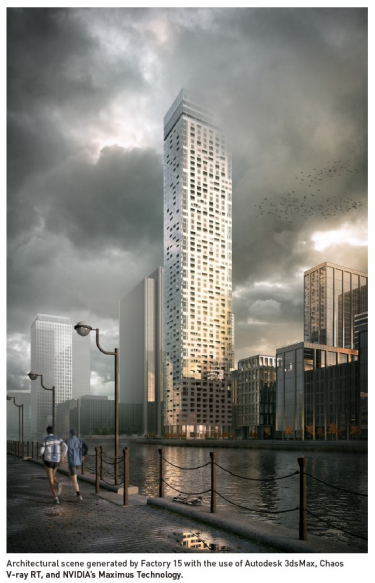Factory Fifteen Illuminates Architectural Visualization Workflow with NVIDIA Maximus
| Share | Tweet |
Factory Fifteen Illuminates Architectural Visualization Workflow with NVIDIA Maximus
.
Factory Fifteen is a UK-based multidisciplinary film and animation studio specializing in architectural visualization for clients that include Knights Architects, Wilkinson Eyre Architects and MVRDV on projects ranging from Olympic stadiums to major bridges. The studio has won many awards for its work including Golden Age’s “Best Architectural 3D Film” and Megalomania’s “Best Architectural 3D Image.” Their architectural work has been featured in many leading architectural magazines, books and design blogs, and their film shorts have also been recognized by the Sundance Film Festival, SXSW, The Creator’s Project, The London Short Film Festival and others.
.
Challenge:
.
Solution:
.
Nicholls had some previous experience with NVIDIA GPUs and thought that a dual-GPU Maximus system might help tackle the core pain points in Factory Fifteen’s workflow. Factory Fifteen installed an NVIDIA Maximus system, an HP Z820 workstation outfitted with NVIDIA Quadro 5000 and Tesla K20 GPUs.
.
“With the Maximus setup the feedback is so instant, I could make incremental changes separately and see the effects of a setting change in near real-time. For the first time I felt completely in control of the test render and its final look,” said Nicholls.
.
“Even more useful than lighting feedback was the material setup feedback I got with V-Ray RT running on Maximus. When creating complex realistic materials you create several maps for reflection, glossiness, bump and displacement. Each of those maps will separately need to be tweaked in material settings to get just the right look. This can be a tedious process of test rendering multiple times and you often change the settings without being able to preview how it might turn out. With Maximus I’ve been able to fine-tune scenes knowing how the changes would impact my projects rather than rendering blind-and it speeds up my process tenfold,” Nicholls continued.
.
Another benefit of working on Maximus is that it enables Factory Fifteen to instantly position HDRI images into scenes. On the CPU, Nichols and his team would have to load the images and rotate them by 15 degrees per test render until they accurately matched the lighting within a scene. On Maximus, HDRI placement happens instantly, saving at least 45 minutes at the front of every scene setup.
.
Impact:
.
Factory Fifteen artists can develop materials in Photoshop on one screen, and in real time see what the effect of those materials would be on a model in 3ds Max with a test render in V-Ray RT when working on a Maximus system. Additionally, there is no slowdown in the viewport while making modifications to a model.
.
“I have found that using V-Ray RT with Maximus has changed many of my usual 3D workflows,” explained Nicholls. “I can continue working within the model while having one of my other screens on the V-Ray RT window, so it’s allowed me to develop materials while modeling and setting up scenes.”
.
With Maximus, the near real-time feedback allows Nicholls and his team to make more incremental tweaks to lighting and materials with the flexibility to adjust materials and lighting details without freezing up entire workstations.
.
“The method of test rendering with the CPU and waiting for each render to finish before making another small adjustment to the render, lighting, or material settings now seems totally outdated,” concluded Nicholls.
 EN
EN













